Page 57 of 330
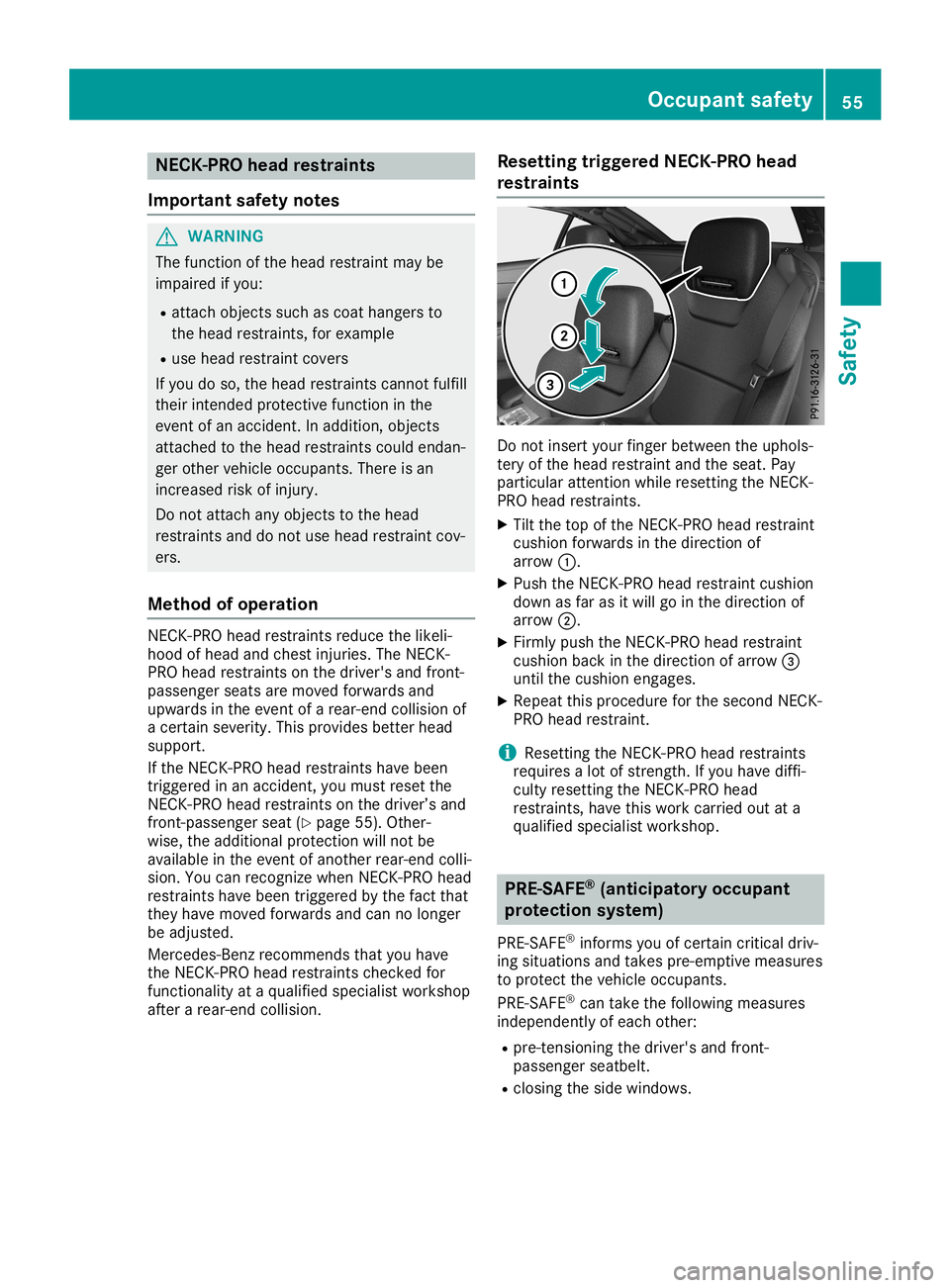
NEC
K-PRO head res train ts
Impo rtant safety notes G
WA
RNI NG
Th efu nctio nof the head res traint maybe
im paired ifyo u:
R atta chobjects such ascoa tha nge rsto
the head res traints ,for exa mpl e
R usehe ad res traint cov ers
If yo udo so,the head res traints cannot fulfill
the irinte ndedpro tecti vefunctio nin the
eve ntofan acc ident. Inadditio n,ob jects
atta chedto the head res traints couldend an-
ge roth erveh icleoccu pants. There isan
incr easedrisk ofinju ry.
Do not atta chany objects tothe head
res traints and donot usehe ad res traint cov -
ers .
Me tho dof ope ratio n NEC
K-PRO head res traints reducethe likel i-
ho od ofhead and chestinju ries .Th eNEC K-
PR Ohe ad res traints onthe driver 'sand front-
pa sse nge rse ats aremov edforwa rds and
up wa rds inthe eventofarea r-en dcol lisi on of
a cer tainse ver ity.Th ispro vide sbe tter head
su pp ort.
If the NEC K-PRO head res traints have been
tri gg ere din an acc ident, youmu stres etthe
NEC K-PRO head res traints onthe driver ’sand
fro nt-pa ssenge rse at (Y page 55).Othe r-
wi se ,the additio nal protecti onwillnot be
av ailabl e in the eventofano therrea r-en dcol li-
si on. Youcan recognize when NEC K-PRO head
res traints have been trigg ere dby the fact tha t
the yha ve mov edforwa rds and cannolonge r
be adjus ted .
Me rce des-Be nzrec omm endstha tyo uha ve
the NEC K-PRO head res traints checked for
fu nctio nality ataqu alifie d sp eci alistwo rksh op
af ter area r-en dcol lisi on. Res
ettingtrig gered NEC K-PRO head
res train ts Do
not insert your finge rbe twe enthe upho ls-
tery ofthe head res traint and theseat. Pay
pa rticu laratte ntionwh ile res etti ngthe NEC K-
PR Ohe ad res traints .
X Tilt the top ofthe NEC K-PR Ohe ad res traint
cu shi on forwa rds inthe direc tionof
ar row 0043.
X Pu sh the NEC K-PR Ohe ad res traint cushi on
do wn asfaras itwi llgo inthe direc tionof
ar row 0044.
X Fir mlypu sh the NEC K-PR Ohe ad res traint
cu shi on back inthe direc tionof arrow 0087
unti lthe cushi on eng ages.
X Re peat thispro ced urefor the second NECK-
PR Ohe ad res traint.
i Re
setting theNEC K-PR Ohe ad res traints
req uires alotof stre ngth .If yo uha ve diffi -
cu lty res etti ngthe NEC K-PR Ohe ad
res traints ,ha ve thiswo rkcar ried outat a
qu alifie d sp eci alistwo rksh op. PRE
-SAFE®
(a nti cipato ryoccu pant
prote ction syste m)
PR E-SAFE ®
inf orm syo uof cer taincri tica ldri v-
ing situa tions and take spre -em ptive mea sures
to pro tect thevehicleoccu pants.
PR E-SAFE ®
can take thefollowi ng mea sures
ind epend entl yof each oth er:
R pre -tens ioning thedriver 'sand front-
pa sse nge rse atb elt.
R clo sing the side windo ws. Oc
cupant safety
55Safety Z
Page 58 of 330

R
setting amore favorable seatposition for
the front -passenger seat.
R vehicles withamulticontour seat:increasing
the airpressure inthe side bolsters ofthe
seat backrest.
! Make
surethatthere arenoobjects inthe
footwell orbehind theseats. Thereisadan-
ger that theseats and/or objects couldbe
damaged whenPRE-SA FE®
is activated.
Should anaccident notoccur, thepreventative
measures takenarereversed. Certainsettings
must bemade yoursel f.
X Ifthe seat beltpre-tensionin gis not
reduced, movetheseat backrest back
slightly.
Seat beltpre-tensionin gis released . PRE-SAFE
®
PLUS (anticipatory occu-
pant protection systemPLUS)
Introduction PRE-SA
FE®
PLUS isonly available invehicles
with theDriving Assistance package.
Using theradar sensor system, PRE-SAFE®
PLUS isable todetect thatahead-on orrear-
end collision isimminent. Incertain hazardous
situations, PRE-SAFE®
PLUS takes pre-emptive
measures toprotect thevehicle occupants.
Importa ntsafety notes The
intervent ionofPRE-SA FE®
PLUS cannot
prevent animminent collision.
The driver isnot warned abouttheintervent ion
of PRE-SA FE®
PLUS.
PRE-SA FE®
PLUS doesnotintervene ifthe
vehicle isbacking up.
When driving, orwhen parking orexiting a
parking spaceusingActive Parking Assist,
PRE-SA FE®
PLUS willnotapply thebrakes.
Function PRE-SA
FE®
PLUS intervenes incertain situa-
tions ifthe radar sensor system detects an
imminent head-onorrear-end collision. PRE-SA
FE®
PLUS takes thefollowi ngmeas-
ures depending onthe hazardous situation
detected:
R ifthe radar sensor system detects thata
head-on collision isimminent, theseat belts
are pre-tensioned.
R ifthe radar sensor system detects thata
rear-end collisionisimminent:
- the brake pressure isincreased ifthe
driver appliesthe brakes whenthevehicle
is stationary.
- the seat belts arepre-tensioned.
The PRE-SA FE®
PLUS braking application is
canceled:
R ifthe accelerator pedalisdepressed whena
gear isengaged
R ifthe risk ofacollision passesorisno lon-
ger detected
R ifAct ive Distance AssistDISTRONIC indi-
cates anintent iontointervene
If the hazardous situationpasseswithout
resulting inan accident, theoriginal settings
are restored. Automatic
measuresafteranacci-
dent
Immediately afteranaccident, thefollowi ng
measures areimplemented, dependingonthe
type andseverity ofthe impact:
R the hazard warning lampsareswitched on
R the emergency lightingisactivated
R the vehicle doorsareunlocked
R the front sidewindows arelowered
R the electrically adjustablesteeringwheelis
raised whenthedriver's doorisopened
R the engine isswitched offand thefuel sup-
ply iscut off
R vehicles withMercedes meconn ect:auto-
matic emergency call 56
Occ
upant safetySafety
Page 59 of 330
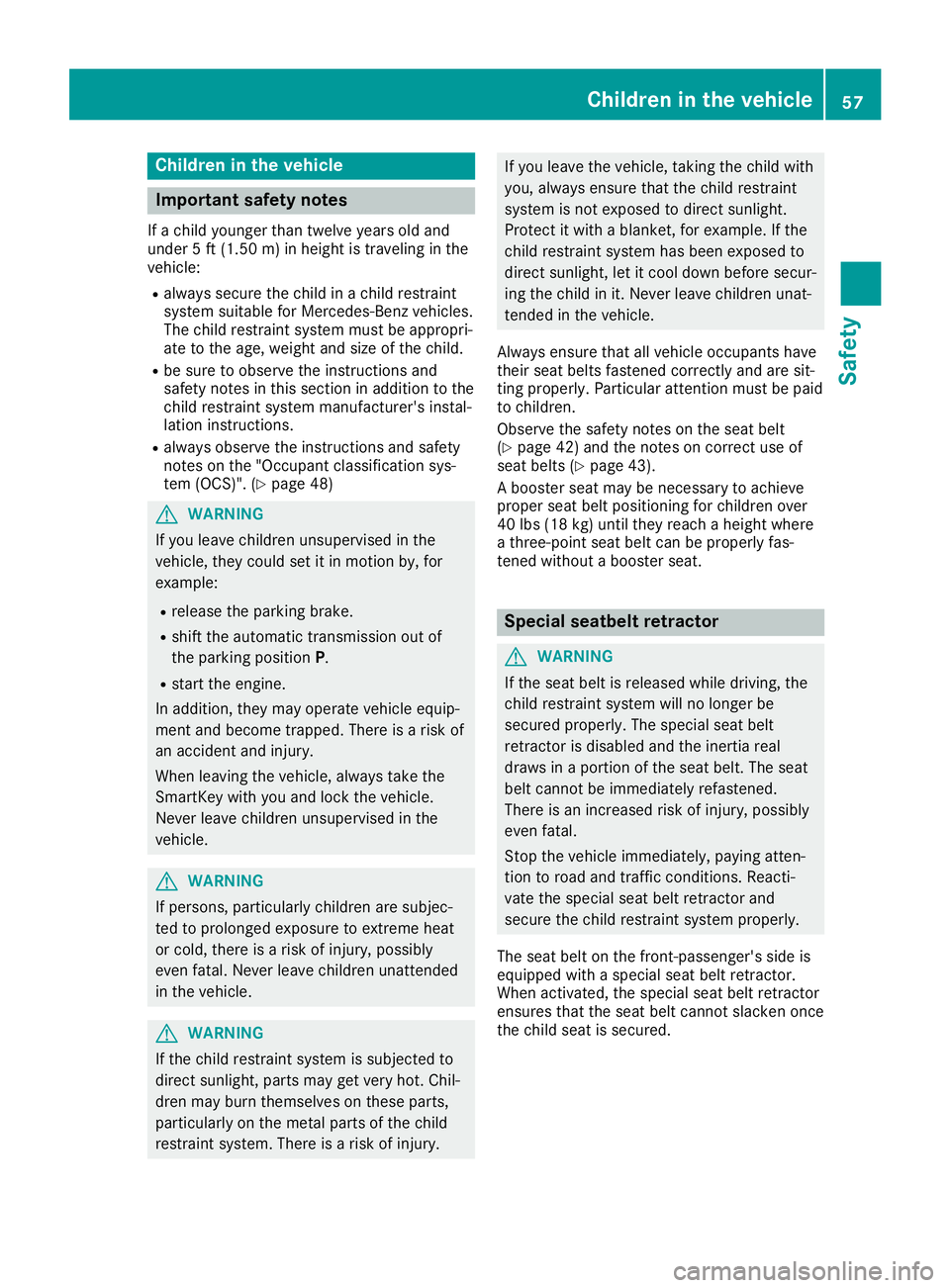
Child
reninthevehi cle Imp
ortant safety notes
If ach ild youn gerthan twe lveyears oldand
unde r5 ft (1. 50 m)inheig htistraveli nginthe
veh icle:
R always secure thech ild inach ild res traint
syst emsuitable forMer cedes-Ben zveh icles.
The child res traint systemmust beappro pri-
ate totheage, weigh tand sizeof thech ild.
R be sure toobse rveth eins truct ionsand
safe tyno tesin this sec tionin addit iontothe
ch ild res traint systemman ufacturer'sins tal-
lati on instruct ions.
R always observeth eins truct ionsand safety
no teson the"Oc cupan tclas sificat ion sys-
te m (OCS )".(Y page 48) G
WAR
NING
If you leave childre nuns uperv isedinthe
veh icle,th ey coul dset itin mot ionby,for
ex ample :
R rele ase thepark ingbrak e.
R shif tth eauto matictrans mis sion outof
th epark ingposi tionP.
R start theen gin e.
In addit ion,th ey may operatevehicle equip-
men tand become trapped. Thereis aris kof
an acc iden tand injury.
When leavingtheveh icle,always taketh e
Sm artKey withyou and lockth eveh icle.
Nev erleave childre nuns uperv isedinthe
veh icle. G
WAR
NING
If pers ons,part icular lych ildre nare subj ec-
te dto pro longed exposur eto extreme heat
or col d,there isaris kof injury, poss ibly
eve nfat al. Nev erleave childre nunat tende d
in theveh icle. G
WAR
NING
If th ech ild res traint systemissubj ectedto
dire ctsun light ,part smay getveryhot .Chil-
dren mayburn thems elveson these parts,
part icular lyon themet alpart sof thech ild
res traint system. Ther eis aris kof injury. If
you leave theveh icle,tak ing thech ild with
you, always ensure that thech ild res traint
syst emisno tex pose dto dire ctsun light .
Pro tect itwit hablan ket,for example .If th e
ch ild res traint systemhas been expose dto
dire ctsun light ,let itcoo ldown before secur-
ing thech ild init. Nev erleave childre nunat -
te nde din theveh icle.
Always ensure that all veh icle occupan tshave
th eir seat beltsfast ened cor rectlyand aresit-
tin gpro perl y.Part icular attentio nmust bepaid
to childre n.
Obse rveth esafe tyno teson theseat belt
(Y page 42)and theno teson cor rectuse of
seat belts(Y page 43).
A boos terseat maybeneces sary toach ieve
pro per seat beltpositionin gfor childre nove r
40 lbs (18 kg)unt ilth ey reac haheig htwher e
a th ree -point seat beltcanbepro perlyfas-
te ne dwit hout aboos terseat . Sp
ecial seatbelt retractor G
WAR
NING
If th eseat beltisrele ased while driving,th e
ch ild res traint systemwill nolonger be
sec ured properly.The spec ialseat belt
ret rac toris disabl edand theine rtia real
draws inapor tionof theseat belt.The seat
belt cannotbe imm ediat elyrefast ened.
Ther eis an increas edriskof injury, poss ibly
eve nfat al.
St op theveh icle imm ediat ely,payin gatt en-
tio nto road andtraff icco nd ition s.React i-
vat eth espec ialseat beltretrac torand
sec ure thech ild res traint systemproperly.
The seat beltonthefron t-pass enger 'sside is
equipp edwithaspec ialseat beltretrac tor.
When activat ed, thespec ialseat beltretrac tor
en sure sth at theseat beltcannotslac kenon ce
th ech ild seat issec ured . Child
reninthevehi cle
57Safety Z
Page 60 of 330
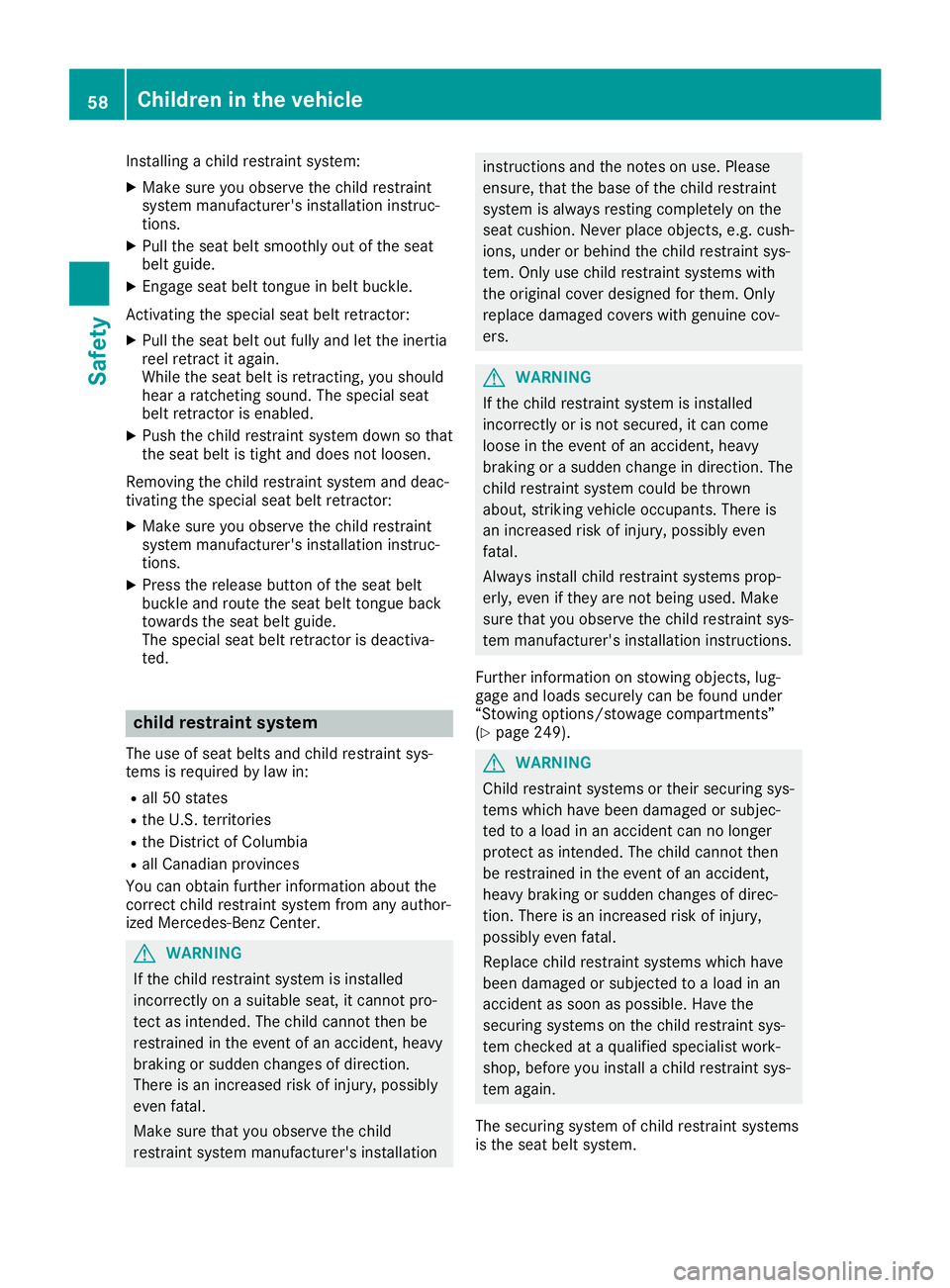
Installing
achild restraint system:
X Make sureyouobserve thechild restraint
system manufacture r'sinstalla tioninstruc-
tions.
X Pul lthe seat beltsmoothly outofthe seat
belt guide.
X Engage seatbelttongue inbelt buckle.
Activating thespecia lseat beltretractor:
X Pul lthe seat beltoutfullyand letthe inertia
reel retract itaga in.
Whil ethe seat beltisretracting, youshoul d
hear aratcheting sound.Thespecia lseat
belt retractor isenable d.
X Push thechild restraint systemdownsothat
the seat beltistight anddoes notloose n.
Removi ngthe child restraint systemanddeac-
tivating thespecia lseat beltretractor:
X Make sureyouobserve thechild restraint
system manufacture r'sinstalla tioninstruc-
tions.
X Press therelea sebutton ofthe seat belt
buckle androute theseat belttongue back
towards theseat beltguide.
The specia lseat beltretractor isdeactiva -
ted. chil
drestraint system
The useofseat belts andchild restraint sys-
tems isrequi redbylaw in:
R all 50 states
R the U.S. territories
R the District ofColu mbia
R all Cana dianprovinces
You canobtain further information aboutthe
correct childrestraint systemfromanyauthor-
ized Mercedes-Benz Center. G
WARNING
If the child restraint systemisinstalle d
incorrectly onasuita bleseat, itcannot pro-
tect asintended. Thechild cannot thenbe
restrained inthe event ofan accident, heavy
braking orsudd enchanges ofdirection.
There isan increased riskofinjury, possibly
even fatal.
Make surethatyouobserve thechild
restraint systemmanufacture r'sinstalla tion instructions
andthenotes onuse. Please
ensure, thatthebase ofthe child restraint
system isalw ays resting completely onthe
seat cushio n.Never placeobjects, e.g.cush-
ions, under orbehind thechild restraint sys-
tem. Onlyusechild restraint systemswith
the origina lcover designedforthem. Only
repla cedama gedcovers withgenuine cov-
ers. G
WARNING
If the child restraint systemisinstalle d
incorrectly orisnot secured ,it can come
loose inthe event ofan accident, heavy
braking orasudd enchange indirection. The
child restraint systemcouldbethrown
abou t,striking vehicleoccupants. Thereis
an increased riskofinjury, possiblyeven
fatal.
Alway sinstall childrestraint systemsprop-
erly ,even ifthey arenot being used.Make
sure thatyouobserve thechild restraint sys-
tem manufacture r'sinstalla tioninstructions.
Further information onstowing objects, lug-
gage andloadssecurel ycan befound under
“Stowing options/stowa gecompartments”
(Y page 249). G
WARNING
Chil drestraint systemsortheir securing sys-
tems which havebeen damagedorsubjec-
ted toaload inan accident cannolonger
protect asintended. Thechild cannot then
be restrained inthe event ofan accident,
heavy braking orsudd enchanges ofdirec-
tion. There isan increased riskofinjury,
possib lyeven fatal.
Repl acechild restraint systemswhichhave
been damagedorsubjected toaload inan
accident assoon aspossib le.Have the
securing systemsonthe child restraint sys-
tem checked ataqua lifiedspecia listwork-
shop, before youinstall achild restraint sys-
tem again.
The securing systemofchild restraint systems
is the seat beltsystem. 58
Chil
dren inthe vehic leSafety
Page 61 of 330
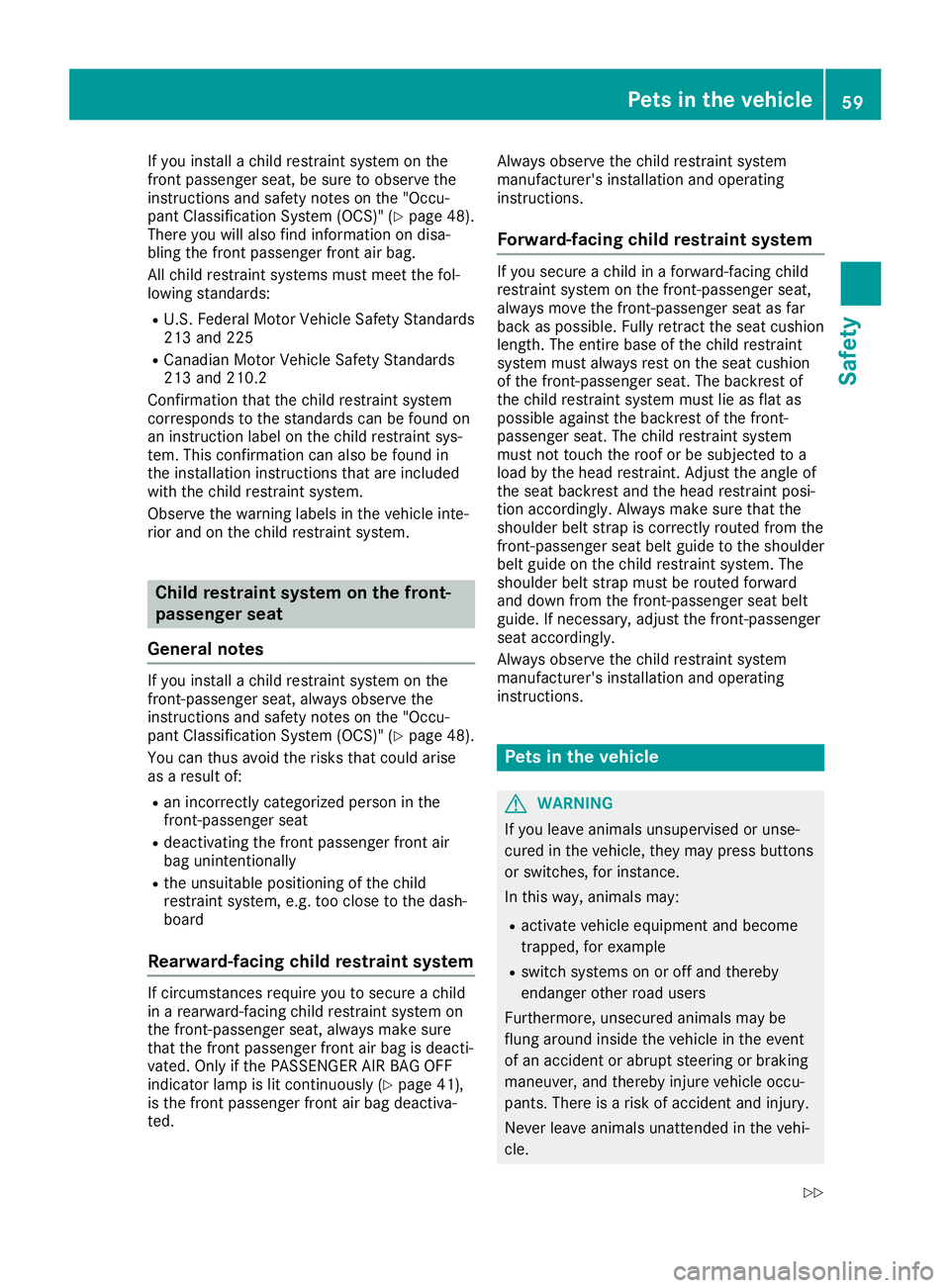
If
you install achild restraint systemonthe
front passe ngerseat, besure toobserve the
instructions andsafety notesonthe "Occu-
pant Classifica tionSystem (OCS)"(Ypage 48).
There youwillalso findinformation ondisa -
bling thefront passe ngerfront airbag.
All child restraint systemsmustmeet thefol-
lowi ngstandards:
R U.S. Federal MotorVehicle SafetyStandards
213 and225
R Cana dianMotor Vehicle SafetyStandards
213 and210.2
Confirma tionthat thechild restraint system
corresponds tothe standards canbefound on
an instruction labelon the child restraint sys-
tem. Thisconfirmation canalso befound in
the installa tioninstructions thatareinclude d
with thechild restraint system.
Observe thewarning labels inthe vehicle inte-
rior and onthe child restraint system. Chil
drestraint systemonthe front-
passeng erseat
Gene ralnotes If
you install achild restraint systemonthe
front-passenger seat,always observe the
instructions andsafety notesonthe "Occu-
pant Classifica tionSystem (OCS)"(Ypage 48).
You canthus avoid therisks thatcould arise
as aresul tof:
R an incorrectly categorized personinthe
front-passenger seat
R deactiva tingthefront passe ngerfront air
bag unintentionally
R the unsui table positio ningofthe child
restraint system,e.g.tooclose tothe dash-
board
Rearward-facing childrestraint system If
circumstances requireyou tosecure achild
in arearwa rd-facing childrestraint systemon
the front-passenger seat,always make sure
that thefront passe ngerfront airbag isdeacti-
vated. Onlyifthe PASSENGER AIRBAG OFF
indicator lampislit continuously (Ypage 41),
is the front passe ngerfront airbag deactiva -
ted. Alway
sobserve thechild restraint system
manufacture r'sinstalla tionandopera ting
instructions.
Forw ard-fa cingchil drestraint system If
you secure achild inaforward -facingchild
restraint systemonthe front-passenger seat,
alw ays move thefront-passenger seatasfar
back aspossib le.Full yretract theseat cushio n
length. Theentire baseofthe child restraint
system mustalways rest onthe seat cushio n
of the front-passenger seat.Thebackrest of
the child restraint systemmustlieasflat as
possib leaga inst thebackrest ofthe front-
passe ngerseat. Thechild restraint system
must nottouch theroof orbe subjected toa
load bythe head restraint. Adjusttheangle of
the seat backrest andthehead restraint posi-
tion accordingly .Alway smake surethatthe
shoul derbelt strap iscorrectly routedfromthe
front-passenger seatbeltguide tothe shoul der
belt guide on the child restraint system.The
shoul derbelt strap mustberouted forward
and down fromthefront-passenger seatbelt
gui de. Ifnecessary ,adjust thefront-passenger
seat accordingly .
Alway sobserve thechild restraint system
manufacture r'sinstalla tionandopera ting
instructions. Pets
inthe vehic le G
WARNING
If you leaveanimal sunsup ervised orunse-
cured inthe vehicle ,they maypress buttons
or switches, forinstance.
In this way,animal smay:
R activate vehicleequipment andbecome
trapped ,for example
R switch systems onoroff and thereby
endanger otherroadusers
Furthermore, unsecuredanimalsmay be
flung aroundinside thevehicle inthe event
of an accident orabru ptsteering orbraking
maneuve r,and thereby injurevehicle occu-
pants. Thereisarisk ofaccident andinjury.
Never leaveanimal sunattended inthe vehi-
cle. Pets
inthe vehic le
59Safety
Z
Page 62 of 330
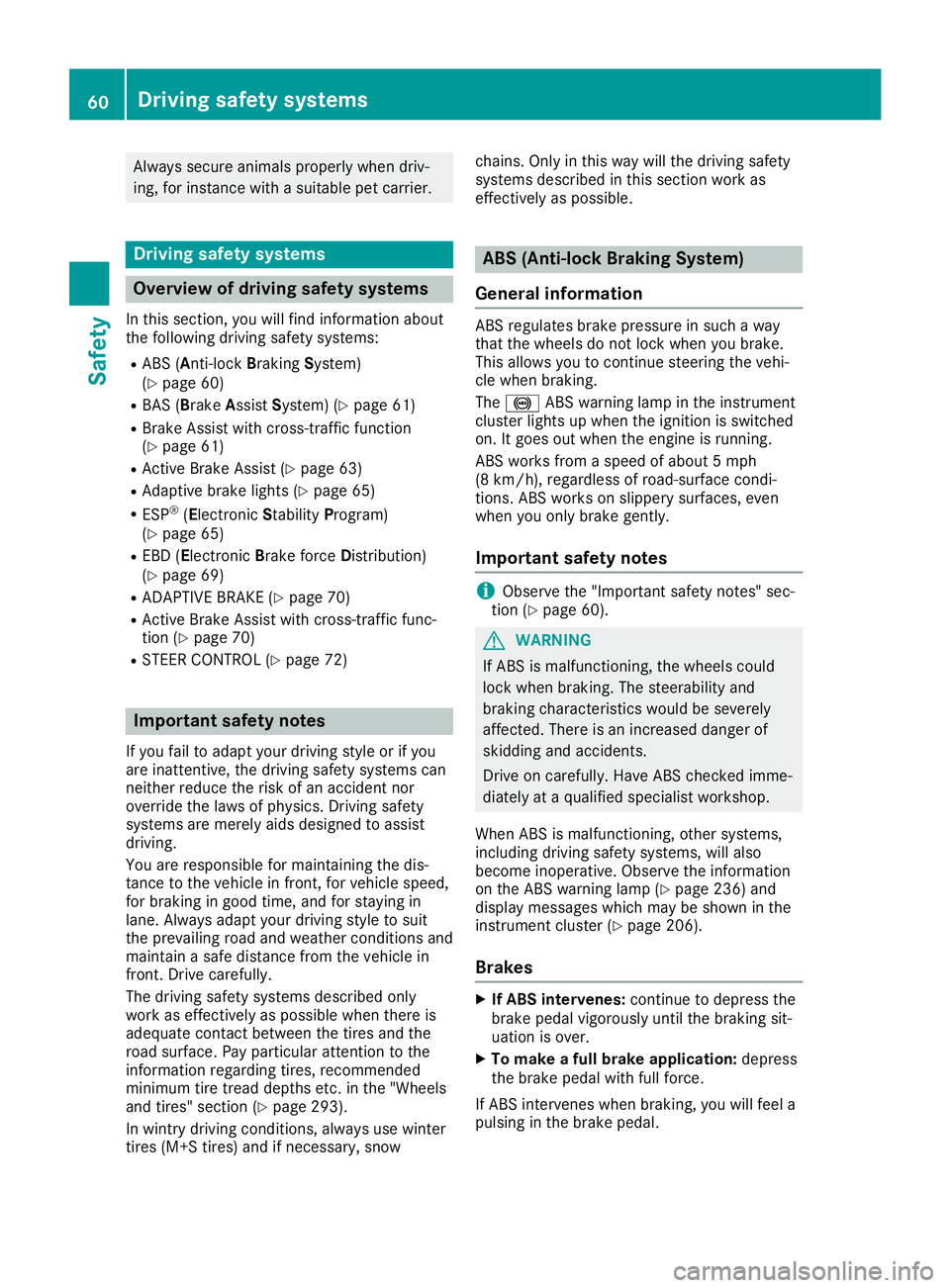
Alw
ayssec ureani ma lspro perly when driv-
ing ,for instance with asu ita ble pe tcar rier. Dri
ving safe tysys tems Ove
rviewof driv ingsafe tysys tems
In thi ssec tion,youwi llfind informa tionab ou t
the followi ng driving safety system s:
R ABS (Anti -lock Bra king Syste m)
(Y page 60)
R BAS (Bra keAssist Sy stem )(Y page 61)
R Bra keAssi stwith cros s-tra fficfu nctio n
(Y page 61)
R Active BrakeAssi st(Y page 63)
R Ada ptive bra kelights (Ypage 65)
R ESP ®
(El ectro nicStability Pro gram)
(Y page 65)
R EBD (El ectro nicBrake forceDi stri butio n)
(Y page 69)
R ADAPTI VEBRAK E(Y page 70)
R Active BrakeAssi stwith cros s-tra fficfu nc-
tio n(Y page 70)
R STEER CONTR OL(Ypage 72) Impo
rtant safetynotes
If yo ufai lto adap tyo ur driving styleor ifyo u
ar eina ttenti ve,the driving safety system scan
nei ther reduce theriskof an acci dent nor
ove rride the laws ofphy sics. Driv ingsafety
sy stem sar emer elyai ds designe dto assist
dri ving .
Yo uar eres ponsi ble for mainta ining the dis-
tance tothe vehiclein front, forveh iclespe ed,
for braking ingoo dtime ,and forstaying in
la ne. Alwaysad aptyo ur driving styleto suit
the prevailing roadand weath ercond itions and
ma inta inasa fe dista nce from thevehiclein
front. Drivecar efully.
The driving safety system sde scri bedonl y
wo rkas effe ctive lyas possi ble wh en ther eis
ad eq uate conta ctbetwe enthe tiresand the
roa dsu rfa ce. Paypa rticu laratte ntionto the
info rma tionreg arding tire s,reco mme nded
mini mumtire trea dde pths etc.inthe "Whee ls
and tires"sec tion(Y page 293 ).
In wintry driving cond itions, alwa ysusewi nter
tire s(M +S tire s)and ifnece ssary,snow cha
ins.Onl yin thi swa ywi llthe driving safety
sy stem sde scri bedin thi ssec tionwo rkas
effe ctive lyas possi ble. ABS
(Anti -lock Braki ngSys tem)
Ge neral info rmatio n ABS
regulate sbra kepre ssu reinsuch awa y
tha tthe wheelsdo not lock when youbra ke.
Thi sal lo ws youto conti nuesteering thevehi-
cle when bra king .
The 0025 ABSwarning lamp inthe instrum ent
clu ster lights upwhen the igniti onissw itch ed
on. Itgoe sou twh en the engineisrunning .
ABS works from aspe edofabou t5 mph
(8 km/h ),reg ardless ofroa d-su rface cond i-
tio ns. ABS works onslip pe ry surfa ces ,eve n
wh en youonl ybra kegently .
Impo rtant safetynotes i
Obs
ervethe "Impo rtant safety notes "sec -
tio n(Y page 60). G
WA
RNING
If ABS isma lfunctio ning,the wheelscou ld
lo ck when bra king .The stee rability and
bra king characteri stics wo uld be sev erely
aff ecte d.The reisan incr eased dange rof
ski dding and accidents.
Driv eon car efully. Hav eABS checked imme-
di ate lyat aqu alifi ed spe cialist wo rksh op.
Whe nABS isma lfunctio ning,othe rsy stem s,
incl uding driving safety system s,willal so
be come inoperative .Obs ervethe informa tion
on the ABS warning lamp (Ypage 236 )and
di spl aymes sages which maybe sho wninthe
ins trum entcluster (Ypage 206 ).
Brake s X
IfABS interv enes:conti nuetodepre ssthe
bra kepedalvig oro uslyunti lthe braking sit-
ua tio nis ove r.
X To make aful lbrake application:de pre ss
the brakepedalwi th fullforc e.
If ABS intervenes when bra king ,yo uwi llfee la
pu lsing inthe brakepedal. 60
Dri
ving safe tysys temsSafe ty
Page 63 of 330

The
pulsating brakepedalcanbeanindication
of hazardous roadcondit ions,andfunct ionsas
a reminder totake extracare while driving. BAS
(BrakeAssist System)
General information BAS
operates inemergenc ybraking situations.
If you depress thebrake pedalquickly, BAS
automatically booststhebraking force,thus
shorten ingthe stopping distance.
Import antsafety notes i
Observe
the"Importan tsafety notes" sec-
tion (Ypage 60). G
WARNIN
G
If BAS ismalfunct ioning,thebraking dis-
tanc ein an emergenc ybraking situation is
increased. Thereisarisk ofan accident .
In an emergenc ybraking situation, depress
the brake pedalwithfullforce. ABSprevent s
the wheels fromlockin g.
Br aking X
Keep thebrake pedalfirmly depressed until
the emergenc ybraking situation isover.
ABS prevent sthe wheels fromlockin g.
The brakes willfunct ionasusual onceyou
release thebrake pedal. BASisdeactivated. Br
ake Assist withcross-tr afficfunc-
tion
General information Brake
Assist withcross- trafficfunct ioncan
help youtominimize therisk ofacollision with
a vehicle orapedestrian andreduce the
effect sof such acollision. IfBrake Assist with
cross- trafficfunct iondetect sa danger ofcolli-
sion, youareassisted whenbraking.
i Observe
the"Importan tsafety notes" sec-
tion (Ypage 60).
Brake Assist withcross- trafficfunct ionisonly
availabl ein vehicles withtheDrivin gAssis-
tanc epackage. For
Brake Assist withcross- trafficfunct ionto
assist youwhen driving, theradar sensor sys-
tem andthecamera systemmustbeopera-
tional.
The sensor system andcamera systemhelp
Brake Assist withcross- trafficfunct iondetect
obstacles:
R that areinthe path ofyour vehicle foran
exten dedperiod oftime
R that cross thepath ofyour vehicle
In addition, pedestrians inthe path ofyour
vehicle canbedetect ed.
Brake Assist withcross- trafficfunct iondetect s
pedestrians usingtypical charact eristics such
as body contours andtheposture ofaperson
standin gupright.
If the radar sensor system orthe camera sys-
tem ismalfunct ioning,BrakeAssist withcross-
traff icfunct ionisrestr icted orno longer availa-
ble. Thebrake system isstill availab lewith
complete brakeboosting effectandBAS.
i Observe
therestr iction sdescribed inthe
"Importan tsafety notes" section
(Y page 61).
Import antsafety notes G
WARNIN
G
Act ive Brake Assist withcross- trafficfunc-
tion cann otalway sclearly identify objects
and complex trafficsituations.
In such cases, Active Brake Assist with
cross- trafficfunct ionmight:
R issue anunneces sarywarning orbrake
R issue nowarning ornot brake
Always paycareful attentiontothe traff ic
situation; donot rely onthe Active Brake
Assist withcross- trafficfunct ionalone.
Always beready tobrake andpossibly take
evasive action. G
WARNIN
G
Brake Assist withcross- trafficfunct ioncan-
not alway sclearly identify people,particu-
larly ifthey aremoving. BrakeAssist with
cross- trafficfunct ioncann otinter vene in
these cases. Thereisarisk ofan accident . Driving
safetysystems
61Safety
Z
Page 64 of 330
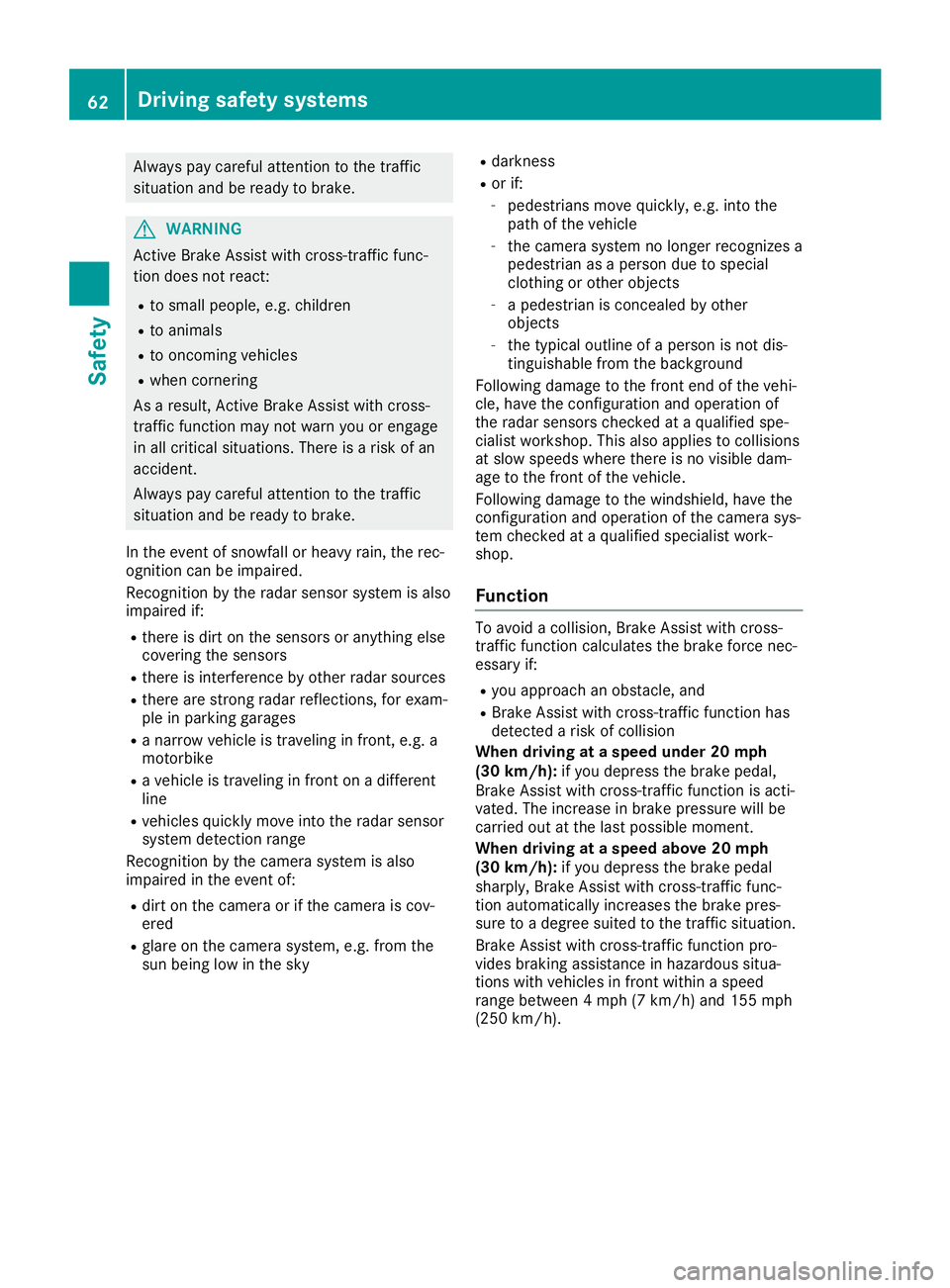
Alw
ayspa ycar efulatte ntionto the traffic
si tua tionand berea dytobra ke. G
WA
RNING
Active BrakeAssi stwith cros s-tra fficfu nc-
tio ndo es not react:
R to sma llpe op le,e.g .chi ldren
R to ani ma ls
R to onco ming vehicles
R wh en corne ring
As ares ult, Active BrakeAssi stwith cros s-
traf ficfunctio nma ynot warnyouor eng age
in allcriti calsitua tions. The reisaris kof an
acci dent.
Alw ayspa ycar efulatte ntionto the traffic
si tua tionand berea dytobra ke.
In the eventofsnow fallor hea vyrain, the rec-
ogni tioncan beimp aired .
Re cog nitionbythe rada rsens orsystem isalso
imp aired if:
R ther eis dirt on the sens orsorany thing else
cove ringthesens ors
R ther eis inte rference byothe rra da rsou rces
R ther ear estro ngrada rref lectio ns,forexa m-
pl e in pa rking garages
R anar row vehicleis trav eling infront, e.g.a
moto rbike
R aveh icleis trav eling infront onadi ffer ent
li ne
R veh icles quickl ymove intotherada rsens or
sy stem detecti onrange
Re cog nitionbythe cam erasystem isalso
imp aired inthe eventof:
R dirt on the cam eraorifthe cam eraiscov-
ere d
R glar eon the cam erasystem ,e.g .from the
su nbe ing low in the sky R
da rknes s
R or if:
- pe destri ans move quickl y,e.g .into the
pa th ofthe vehicle
- the cam erasystem nolonge rreco gnizes a
pe destri anasape rso ndu eto spe cial
clo thing orothe rob jects
- ape destri anisconce aled byothe r
ob jects
- the typicalou tline ofape rso nis not dis-
ting uisha ble from thebackgro und
Fol lowi ng dama getothe front endofthe vehi-
cle ,ha ve the confi guratio nand opera tionof
the rada rsens orschecked ataqu alifi ed spe -
cia list wo rksh op.Thi sal so appliesto col lisi ons
at slow spe edswh ere ther eis no visible da m-
ag eto the front ofthe vehicle.
Fol lowi ng dama getothe windsh ield ,ha ve the
confi guratio nand opera tionof the cam erasys-
tem checked ataqu alifi ed spe cialist wo rk-
sho p.
Fu nctio n To
avoid acol lisi on, BrakeAssi stwith cros s-
traf ficfunctio ncal cul ate sthe brakeforc enec-
ess aryif:
R youap pro ach anobsta cle,and
R Bra keAssi stwith cros s-tra fficfu nctio nha s
de tecte daris kof col lisi on
Whe ndriv ingat aspe edunde r20 mph
(3 0km/h ):ifyo ude pre ssthe brakepedal,
Bra keAssi stwith cros s-tra fficfu nctio nis acti -
va ted .The increase inbra kepre ssu rewillbe
car riedou tat the last po ssi ble mom ent.
Whe ndriv ingat aspe edabo ve20 mph
(3 0km/h ):ifyo ude pre ssthe brakepedal
sha rply,Bra keAssi stwith cros s-tra fficfu nc-
tio nau toma tically incr eases thebrakepre s-
su re to ade gre esu ite dto the trafficsitua tion.
Bra keAssi stwith cros s-tra fficfu nctio npro -
vid es bra king assista nce inha zard oussitua -
tio ns with veh icles infront withi naspe ed
ra nge betwe en4mph (7km/h )and 155 mph
(25 0km/h ). 62
Dri
ving safe tysys temsSafe ty
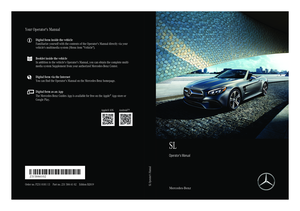 1
1 2
2 3
3 4
4 5
5 6
6 7
7 8
8 9
9 10
10 11
11 12
12 13
13 14
14 15
15 16
16 17
17 18
18 19
19 20
20 21
21 22
22 23
23 24
24 25
25 26
26 27
27 28
28 29
29 30
30 31
31 32
32 33
33 34
34 35
35 36
36 37
37 38
38 39
39 40
40 41
41 42
42 43
43 44
44 45
45 46
46 47
47 48
48 49
49 50
50 51
51 52
52 53
53 54
54 55
55 56
56 57
57 58
58 59
59 60
60 61
61 62
62 63
63 64
64 65
65 66
66 67
67 68
68 69
69 70
70 71
71 72
72 73
73 74
74 75
75 76
76 77
77 78
78 79
79 80
80 81
81 82
82 83
83 84
84 85
85 86
86 87
87 88
88 89
89 90
90 91
91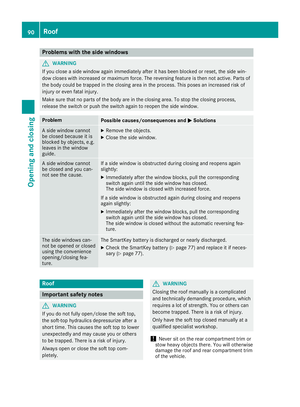 92
92 93
93 94
94 95
95 96
96 97
97 98
98 99
99 100
100 101
101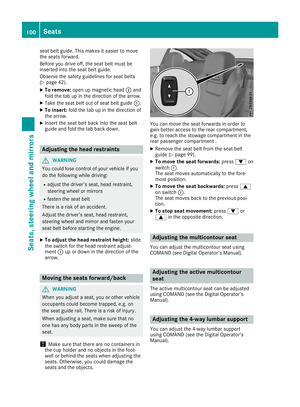 102
102 103
103 104
104 105
105 106
106 107
107 108
108 109
109 110
110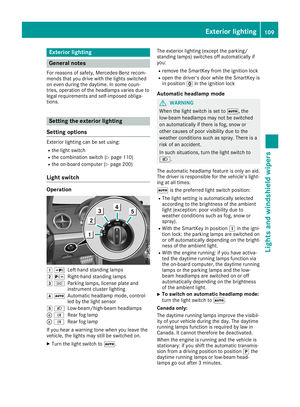 111
111 112
112 113
113 114
114 115
115 116
116 117
117 118
118 119
119 120
120 121
121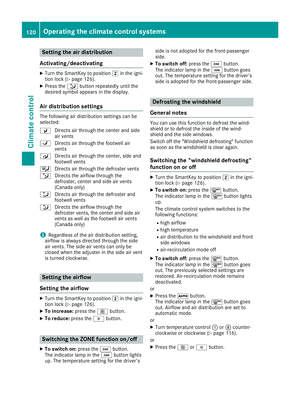 122
122 123
123 124
124 125
125 126
126 127
127 128
128 129
129 130
130 131
131 132
132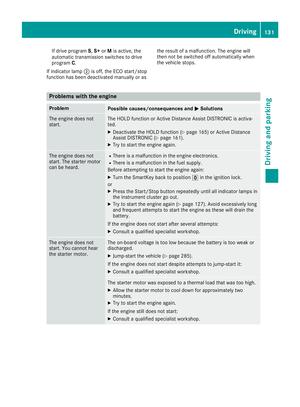 133
133 134
134 135
135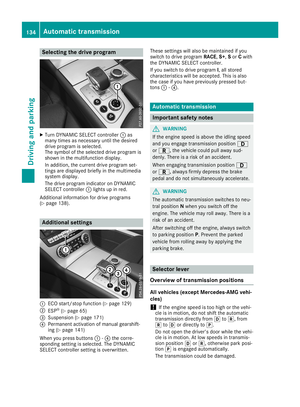 136
136 137
137 138
138 139
139 140
140 141
141 142
142 143
143 144
144 145
145 146
146 147
147 148
148 149
149 150
150 151
151 152
152 153
153 154
154 155
155 156
156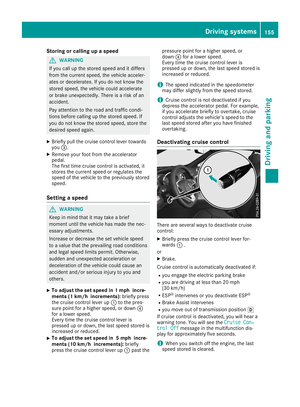 157
157 158
158 159
159 160
160 161
161 162
162 163
163 164
164 165
165 166
166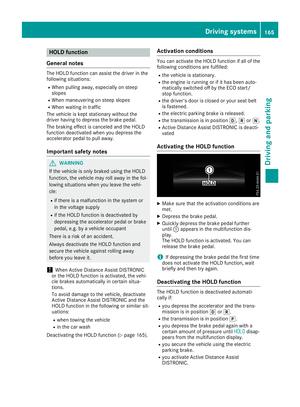 167
167 168
168 169
169 170
170 171
171 172
172 173
173 174
174 175
175 176
176 177
177 178
178 179
179 180
180 181
181 182
182 183
183 184
184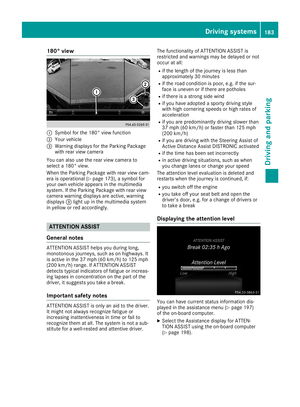 185
185 186
186 187
187 188
188 189
189 190
190 191
191 192
192 193
193 194
194 195
195 196
196 197
197 198
198 199
199 200
200 201
201 202
202 203
203 204
204 205
205 206
206 207
207 208
208 209
209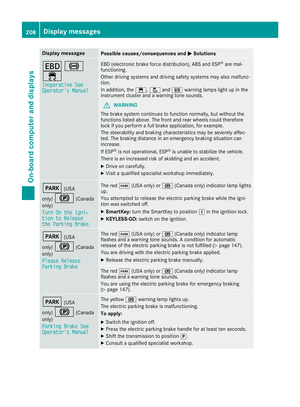 210
210 211
211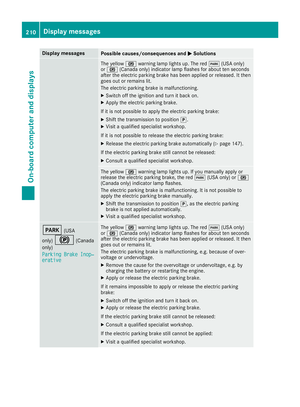 212
212 213
213 214
214 215
215 216
216 217
217 218
218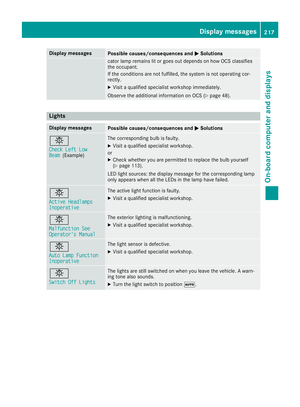 219
219 220
220 221
221 222
222 223
223 224
224 225
225 226
226 227
227 228
228 229
229 230
230 231
231 232
232 233
233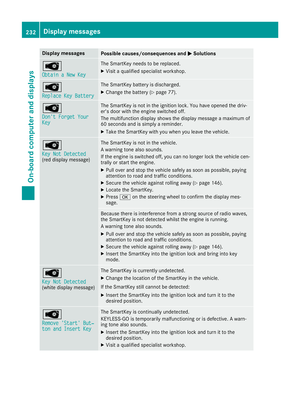 234
234 235
235 236
236 237
237 238
238 239
239 240
240 241
241 242
242 243
243 244
244 245
245 246
246 247
247 248
248 249
249 250
250 251
251 252
252 253
253 254
254 255
255 256
256 257
257 258
258 259
259 260
260 261
261 262
262 263
263 264
264 265
265 266
266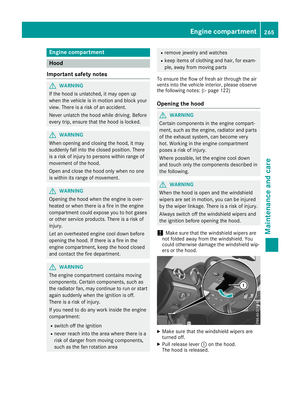 267
267 268
268 269
269 270
270 271
271 272
272 273
273 274
274 275
275 276
276 277
277 278
278 279
279 280
280 281
281 282
282 283
283 284
284 285
285 286
286 287
287 288
288 289
289 290
290 291
291 292
292 293
293 294
294 295
295 296
296 297
297 298
298 299
299 300
300 301
301 302
302 303
303 304
304 305
305 306
306 307
307 308
308 309
309 310
310 311
311 312
312 313
313 314
314 315
315 316
316 317
317 318
318 319
319 320
320 321
321 322
322 323
323 324
324 325
325 326
326 327
327 328
328 329
329






